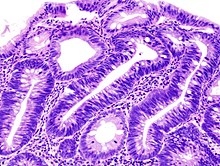Adenoma
| Classification according to ICD-10 | |
|---|---|
| D36 | Benign neoplasm in other and unspecified locations |
| D36.9 | Benign neoplasm in unspecified location |
| ICD-10 online (WHO version 2019) | |
An adenoma (from ancient Greek ἀδήν adēn "gland" and -ωμα -ōma as part of the word meaning "swelling", "effusion") is a benign swelling of mucous membrane or glandular tissue and can generally affect any organ .
Most often, however, the adenoma occurs as a polyp in the gastrointestinal tract . Other common forms affect the thyroid , adrenal glands, and ovaries . In the female breast or mammary gland , it usually occurs as a fibroadenoma with the participation of glandular and connective tissue .
If several adenomas occur, one speaks of adenomatosis .
Various adenomas

Hidradenoma of the sweat glands
- Adenomas of the gastrointestinal tract bulge into the intestines and can lead to blood in the stool during stool passage or growth.
As there is a tendency for the adenomas to transform into malignant cancer , diagnosis and removal is carried out as part of a colonoscopy and a subsequent microscopic examination to rule out colon cancer . - Adenomas of the tonsils , also commonly referred to as polyps in the pharyngeal tonsils, can lead to breathing difficulties and increased susceptibility to infection of the ENT areas. In the event of complaints, the tonsils are usually cut off or completely removed in childhood (adenotomy, surgically using a scraper or laser); It is important to consider the bleeding tendency, which could lead to postoperative complications.
- Adenomas of the sweat glands are very rare.
- Thyroid adenomas may produce excess hormones . The spectrum of symptoms can range from palpitations, tremors, sweating and weight loss to cravings. The affected part of the thyroid is surgically removed or destroyed by radioiodine therapy .
- Adrenal adenomas also produce hormones, with symptoms varying depending on the hormone. Adrenal adenomas are treated by surgical removal of the adenoma or the affected adrenal gland.
- Adenomas of the prostate ( benign prostatic hyperplasia ) are common in men aged 50 and over, and BPH is a widespread disease .
- In the case of adenomas of the ovaries , symptoms only appear when they displace other organs due to their size. The most common symptoms are a feeling of fullness, emptying disorders of the bowel and bladder, as well as lower back and abdominal pain. If the adenoma produces hormones, bleeding outside of the normal range may occur. Depending on the size of the adenoma, therapy is carried out either by laparoscopy or by open surgical removal of the affected ovary.
From the age of 40, the fallopian tube is also removed; after menopause, the uterus , both fallopian tubes and ovaries. - Fibroadenomas are the most common benign breast tumor between the ages of 20 and 40. They can be felt as a lump in the breast, can be easily demarcated from the surrounding breast tissue and are easy to move. The diagnosis is made by sonography or puncture . The breast fibroadenoma practically does not degenerate. It is assumed that hormonal dysregulation of the estrogens and gestagens is responsible for the development. They are more common in animals, especially in cats (→ Feline Fibroadenomatosis ).
- Liver cell adenomas can develop in women with a genetic disposition due to long-term use of oral contraceptives . They are surrounded by a capsule, occur individually or in groups, are most commonly found in the right lobe of the liver, and grow to be several centimeters. A diagnosis is often made based on severe abdominal pain from necrosis or bleeding from an adenoma. About a tenth of the bleeding is so severe that it becomes life-threatening. The diagnosis is possible by means of computed tomography with a contrast medium , whereby a differentiation from focal nodular hyperplasia (FNH) by functional scintigraphy is necessary. If a diagnosis is made, it is imperative to refrain from taking any further hormones. In the case of very large adenomas (diameter of 10 cm and more), surgical removal may be advisable; otherwise, therapy is usually not necessary, as the transition to carcinoma is not known.
- Pituitary adenomas are benign tumors that lead to the release of one or more hormones from the anterior pituitary gland . The symptoms strongly depend on which hormones are excessively produced. The most common pituitary adenoma is the prolactinoma , which causes an increased release of the hormone prolactin . In women, this can lead to menstrual disorders, sterility , breast growth and milk flow . Sexual disinterest, rarely breast enlargement, or chest pain are commonly observed in men. Another pituitary adenoma produces excessive somatotropin ( growth hormone ). In children this causes giant stature , in adults enlarged hands, feet, nose, chin, lips or tongue ( acromegaly ). If the tumor presses on healthy pituitary tissue, in addition to the overfunction of the individual hormones, the pituitary gland is sometimes underactive . In order to confirm the diagnosis, the suspected hormones in the blood are determined and the tumor is searched for using computed tomography or magnetic resonance imaging . If a growth hormone-producing tumor is suspected, provaction tests must also be carried out ( glucose load test ). The aim of treatment is to completely remove the tumor. In the case of tumors that produce growth hormone, there is also the possibility of reducing the size of the tumor with medication. This happens especially before an operation when the tumor is still too large to be completely removed or is difficult to separate from the neighboring tissue. If surgery cannot be performed, drugs are used to treat acromegaly (e.g. lanreotide , octreotide, or pegvisomant ) and prolactinoma (e.g. bromocriptine , lisuride , quinagolide, or cabergoline ). If the operation cannot be carried out and drug therapy is unsuccessful, radiation therapy to reduce the size of the tumor can be considered.
- The pleomorphic adenoma is a benign tumor, which often occurs in the parotid gland (parotid) rare in other salivary glands.
- Primary hyperparathyroidism can occur in the context of genetically determined multiple endocrine adenomatosis .
See also
Web links
Commons : Adenome - collection of images, videos and audio files
Wiktionary: Adenoma - explanations of meanings, word origins, synonyms, translations
- C. Smith, RJ Parsons, WM Bogart: Giant intracanalicular fibroadenoma. With report of five cases. In: California medicine. Volume 75, number 2, August 1951, pp. 101-104, ISSN 0008-1264 , PMID 14848732 , PMC 1520979 (free full text) (case description of fibroadenoma from 1951 with pictures, English)
Individual evidence
- ↑ sessile adenoma in the endoscope. endoskopischer-atlas.de
- ↑ villous adenoma in the endoscope. endoskopischer-atlas.de
- ↑ According to Herbert Renz-Polster et al. (Ed.): Basic textbook internal medicine . Urban & Fischer, Munich 2004, ISBN 3-437-41052-0 .
- ↑ F. Kuhlencordt, H.-P. Kruse: Diseases of the parathyroid gland and disorders of the calcium phosphate metabolism. In: Rudolf Gross , Paul Schölmerich , Wolfgang Gerok (Eds.): 1000 memoranda of internal medicine. Schattauer, Stuttgart / New York 1971; 4th, completely revised edition ibid 1989 (= UTB für Wissenschaft / Uni-Taschenbücher. Volume 522), ISBN 3-7945-1282-0 , pp. 167–169, here: p. 168.
